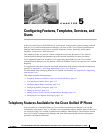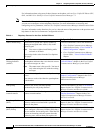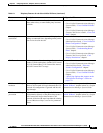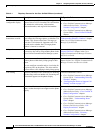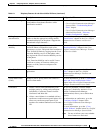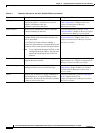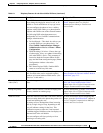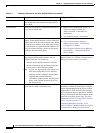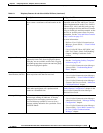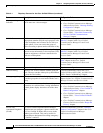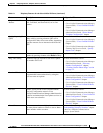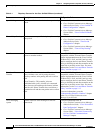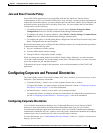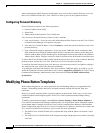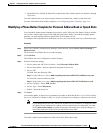
5-8
Cisco Unified IP Phone 6921, 6941, and 6961 Administration Guide for Cisco Unified Communications Manager 7.1 (SCCP)
OL-19025-01
Chapter 5 Configuring Features, Templates, Services, and Users
Telephony Features Available for the Cisco Unified IP Phone
Hold Status Enables phones with a shared line to distinguish
between the local and remote lines that placed a
call on hold.
No configuration is required.
Hold/Resume Allows the user to move a connected call from an
active s
tate to a held state.
• Requires no configuration, unless you
want to use music on hold. See
“Music-on-Hold” in this table for
information.
• See “Hold Reversion” in this table.
Hunt Group Provides load sharing for calls to a main directory
n
umber. A hunt group contains a series of directory
numbers that can answer the incoming calls. When
the first directory number in the hunt group is busy,
the system hunts in a predetermined sequence for
the next available directory number in the group
and directs the call to that phone.
For more information, refer to:
• Cisco Communications Manager
Administration Guide, “Hunt Group
Configuration” chapter.
• Cisco Unified Communications Manager
System Guide, “Understanding Route
Plans” chapter.
Intercom Allows users to place and receive intercom calls
u
sing programmable phone buttons. You can
configure intercom line buttons to:
• Directly dial a specific intercom extension.
• Initiate an intercom call and then prompt the
user to enter a valid intercom number.
Note If your user logs into the same phone on a
daily basis using their Cisco Extension
Mobility profile, assign the phone button
template that contains intercom
information to their profile, and assign the
phone as the default intercom device for
the intercom line.
For more information, go to the “Intercom”
chapter in the Cisco U
nified Communications
Manager Feature and Services Guide.
Join Across Lines Allows users to combine calls that are on multiple
phone line
s to create a conference call.
Some JTAPI/TAPI applications are not
compatible with the Join and Direct Transfer
feature implementation on the Cisco Unified
IP Phone 6921, 6941, and 6961 and you may
need to configure the Join and Direct Transfer
Policy to disable join and direct transfer on the
same line or possibly across lines. For more
information, see the “Join and Direct Transfer
Policy” section on page 5-13.
For more information, go to the “Cis
co
Unified IP Phone” chapter in the Ci
sco Unified
Communications Manager System Guide.
Table 5-1 Telephony Features for the Cisco Unified IP Phone (continued)
Feature Description Configuration Reference




